Colours in Korean | To the Rainbow and Beyond 🌈
Discover The All Important Colours in Korean
When learning a new language, one of the first lists of vocabulary you should be learning are the colours.

So today we’re talking about colours in Korean!
Colours are among the basic building blocks of vocabulary that you’ll use on a regular basis – it’s best to learn them early and learn them well.
In Korean, colours can have multiple names.
This can be a bit confusing for Korean language learners.
For example, in Korean, the word “white” can be 흰 [hyin] or 하얀 [hayan], both of which are commonly used.
There are more words to learn than you might think.
In addition, there are specialised words for certain colours in Korean, indicating a very particular shade or hue.
Don’t worry though, this article has you covered.
That being said – let’s get started!
Colours in Korean | The Word “Colour”
Colours in Korean | Basic Colours
Colours in Korean | Specific Colours
Colours in Korean | Dark vs Light Colours
Colours in Korean | Cultural Meanings
BONUS | Free Quiz
Colours in Korean | FAQs
How to Say the Word “Colour” in Korean
In Korean, the word “colour” is translated as 색깔 [saek-kkal], which is often shortened to 색 [saek].
Colour in Korean is 색 [saek]
👉 This is very important to know because in Korean, 색 [saek] is often attached to the actual name of the colour.
For example, instead of just saying “blue” or 파란 [paran], it’s more common to say “blue colour” or 파란색 [paran-saek].
Keep this in mind as you browse the lists below.
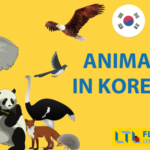
170+ Animals in Korean 🐙 The Ultimate Guide for All The Animals!
From Cat to Butterfly, Koala, Crocodile and Sparrow, find out the names of 170+ animals in Korean in this fantastic vocabulary guide. PLUS flashcards!
Basic Colours in Korean
Here are the basic colours in Korean:
| English | Korean | Romanisation |
|---|---|---|
| Black* |
검은
검은색 – 검정 검정색 | geom-eun geom-eun-saek – geom-jung geom-jung-saek |
| Blue |
파란
파란색 | paran paran-saek |
| Brown** | 갈색 | gal-saek |
| Gray** | 회색 | hoe-saek |
| Green |
초록
초록색 | chorok chorok-saek |
| Orange |
주황
주황색 | juhwang juhwang-saek |
| Pink*** |
분홍
분홍색 – 핑크 핑크색 | bunhong bunhong-saek – pink pink-saek |
| Purple |
보라
보라색 | bora bora-saek |
| Red |
빨간
빨간색 | ppalgan ppalgan-saek |
| White**** |
흰
흰색 – 하얀 하얀색 | hyin hyin-saek – hayan hayan-saek |
| Yellow |
노란
노란색 | noran noran-saek |
* There are two base words for “black” in Korean (검은, 검정), both of which are interchangeable and commonly used.
** 갈색 [gal-saek] and 회색 [hoe-saek] should always be used with 색 [saek], never with only the base word
*** Nowadays, the Korean pronunciation of the English word for pink (핑크) is more commonly used and 분홍 [bunhong] is considered a bit old-fashioned.
**** There are two base words for “white” in Korean (흰, 하얀) both are interchangeable and commonly used.
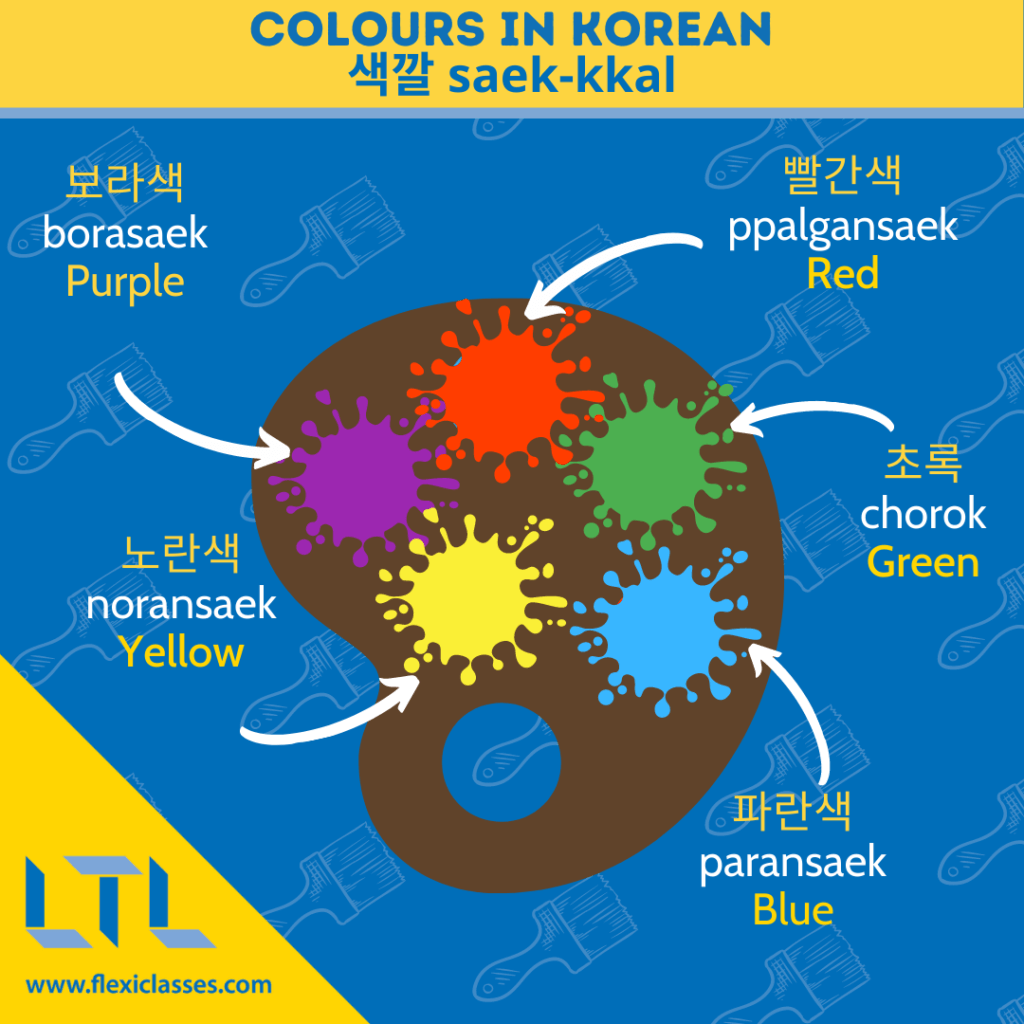
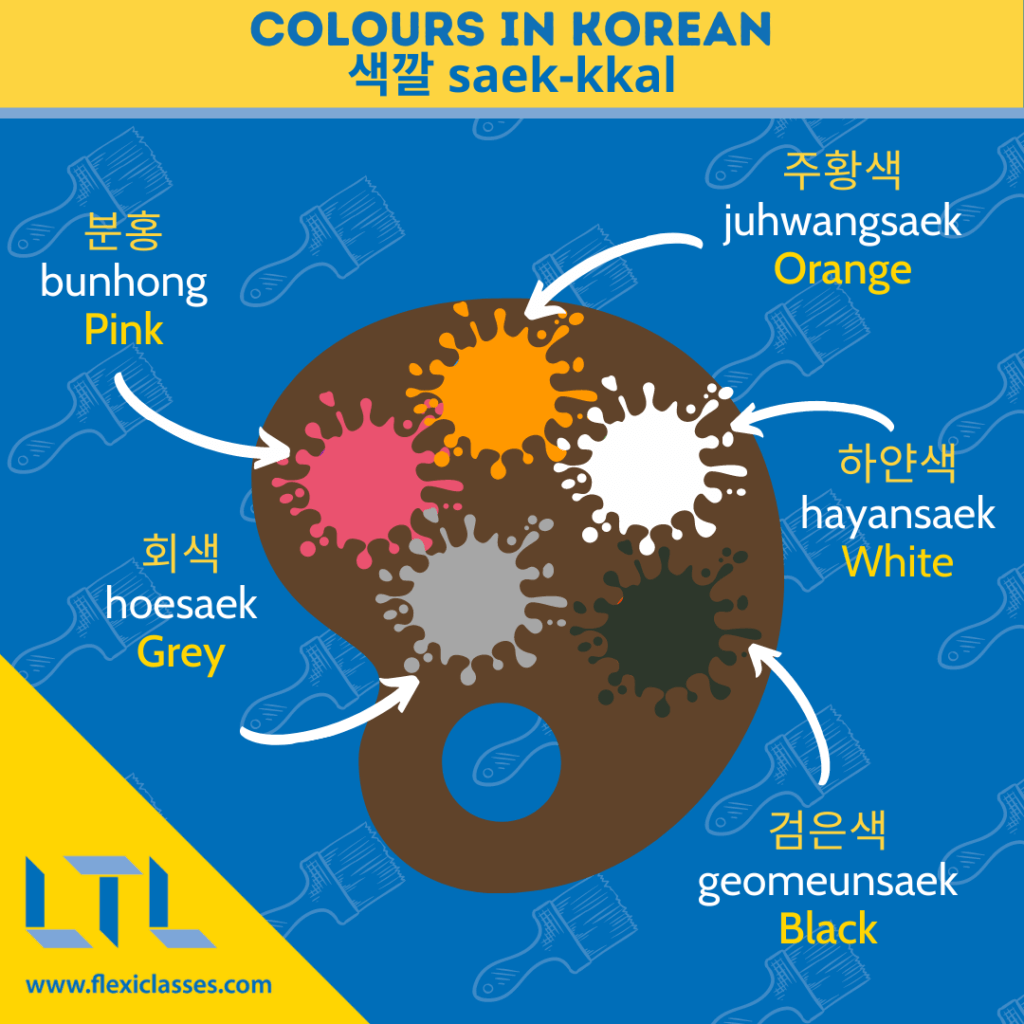
Specific Colours in Korean
Now that you know the basic colours in Korean, how about some more uncommon ones?
Korean has a wide range of specialised words for colour, some more literal and obscure than others.
Here is a list of some of the more useful terms:
| English | Korean | Romanisation | Notes |
|---|---|---|---|
| Gold | 금색 | geum-saek | The base word 금 [geum] literally means “gold,” as in the precious metal. |
| Indigo | 남색 | nam-saek | |
| Light green | 연두색 | yeondu-saek | |
| Mint | 민트색 | minteu-saek | This is a relatively new word in the Korean lexicon, based on the English word “mint”. |
| Silver | 은색 | eun-saek | The base word 은 [eun] literally means “silver,” as in the precious metal. |
| Sky | 하늘색 | haneul-saek | The base word 하늘 [haneul] literally means “sky,” so if you’re referring to a sky blue colour, be sure to classify it with 색 [saek]. |
| Rainbow | 무지개색 | mujigae-saek | The base word 무지개 [mujigae] literally means “rainbow,” as in the natural phenomenon. |
| Turquoise | 청록색 | chungnok-saek |
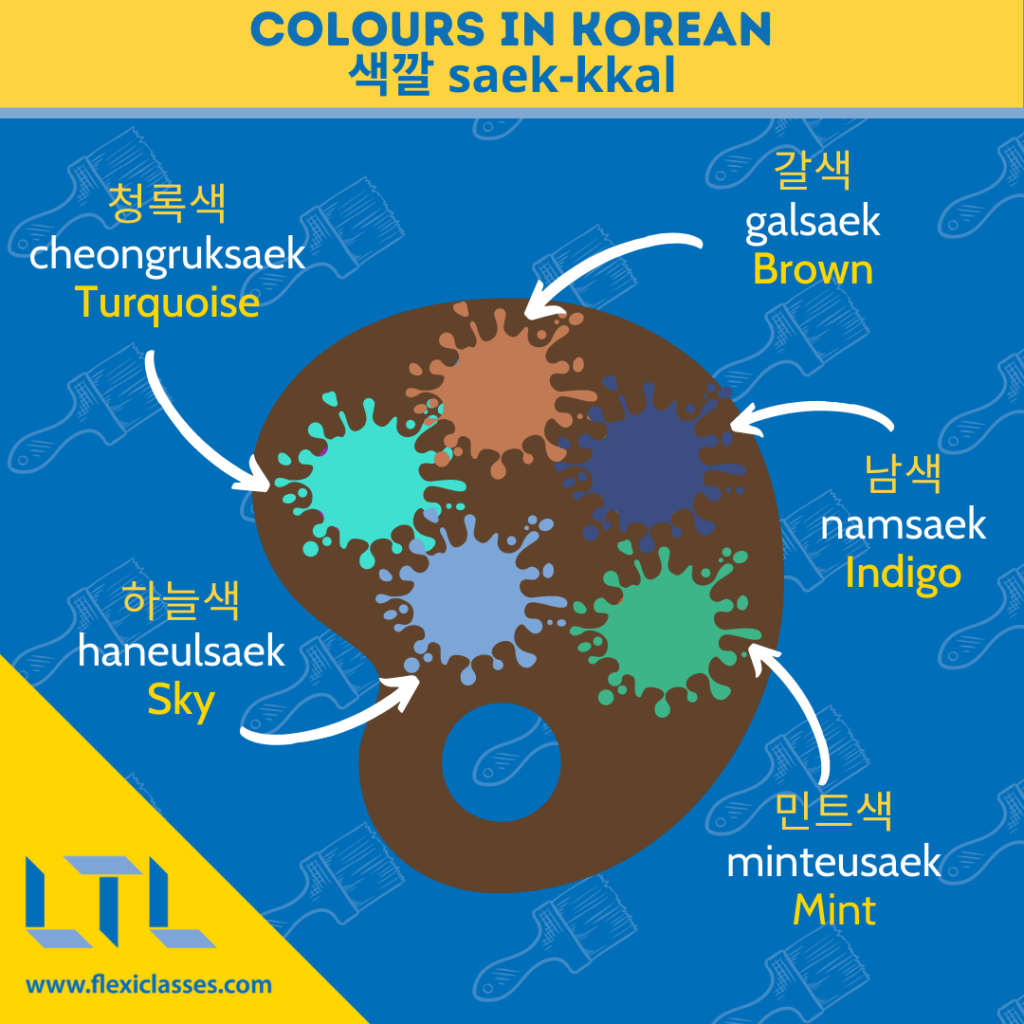

Dark Colors vs. Light Colours in Korean
In Korean, there is an easy way to specify whether a colour is light or dark.
To specify a light/pale colour, add 연 [yeon] to the beginning of the word.
To specify a dark colour, add 진 [jin] to the beginning of the word.
Let’s put it in practice.
Take the Korean word for “purple,” which is 보라색 .
- If we want to say “light purple,” then we would add 연 [yeon] to the front, changing the word to 연보라색 .
- If we want to say “dark purple,” then we would add 진 [jin] to the front, changing the word to 진보라색 .
Use these modification rules for any other colours in Korean.
You can now specify whether it’s light or dark. It’s as simple as that!
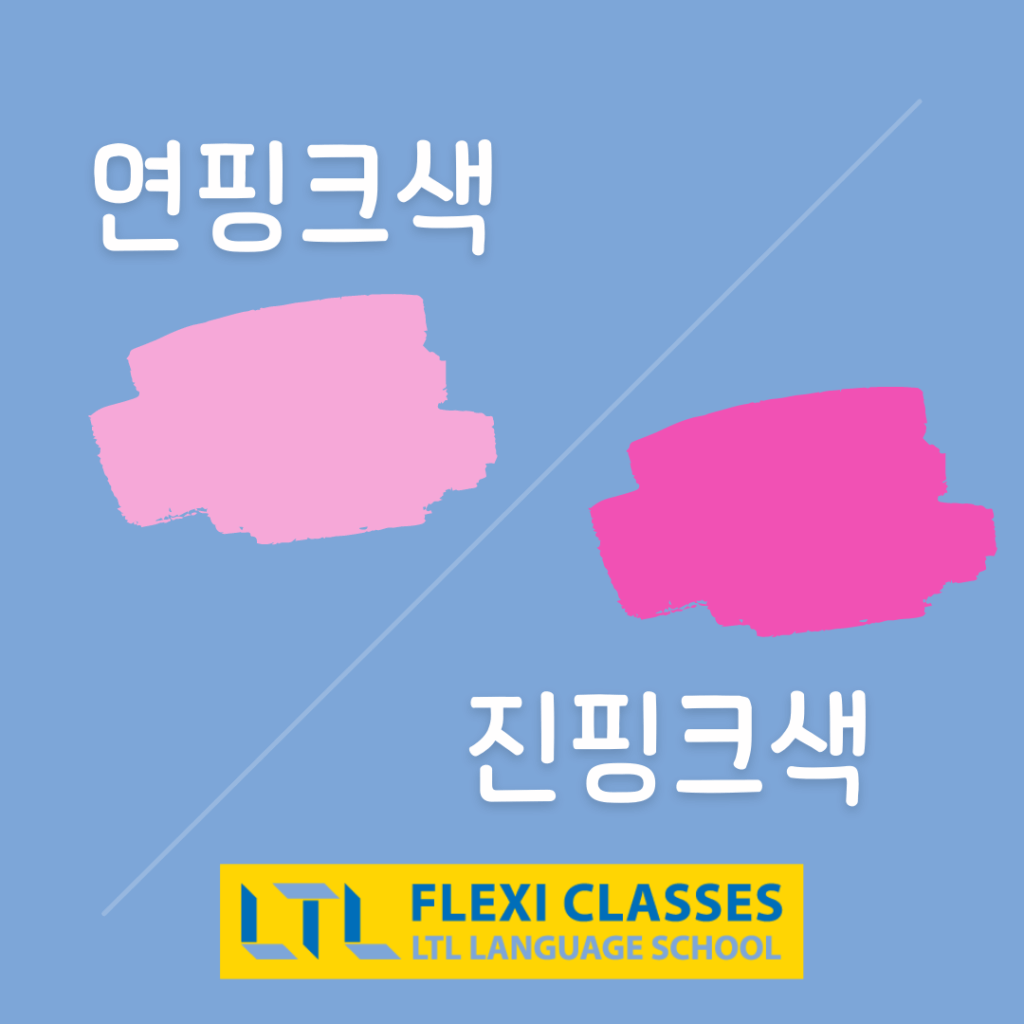
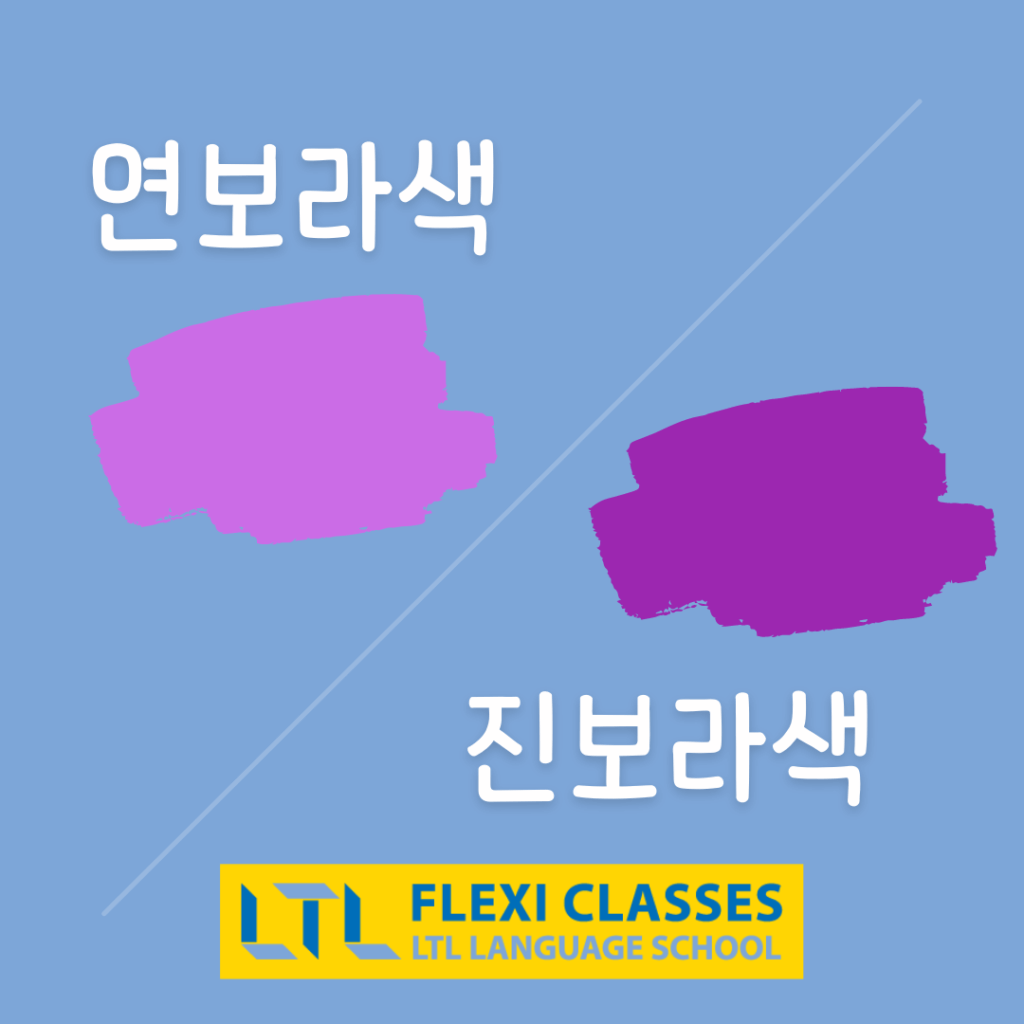
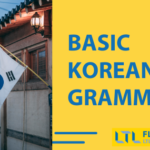
Basic Korean Grammar // The Top 5 Korean Grammar Points for Beginners
You got to start somewhere, right? Our Basic Korean Grammar Guide will help you get started on learning and actually speaking the Korean language.
The Meaning of Colours in Korean Culture
What do a bibimbap, a Hanbok and the Korean flag have in common?
Sure, they all come from Korea, but they also follow a very specific colour pattern!
Let me explain.
In the Korean colour symbolism, five specific colours hold great importance. They are called 오방색 obangsaek, or Five Direction Colours.
The five traditional Korean colours (오방색) are white, black, blue, yellow and red
Each colour corresponds to an element, a direction and a season:
| White | Black | Blue | Yellow | Red |
|---|---|---|---|---|
| West | North | East | Center | South |
| Metal | Water | Wood | Earth | Fire |
| Autumn | Winter | Spring | / | Summer |
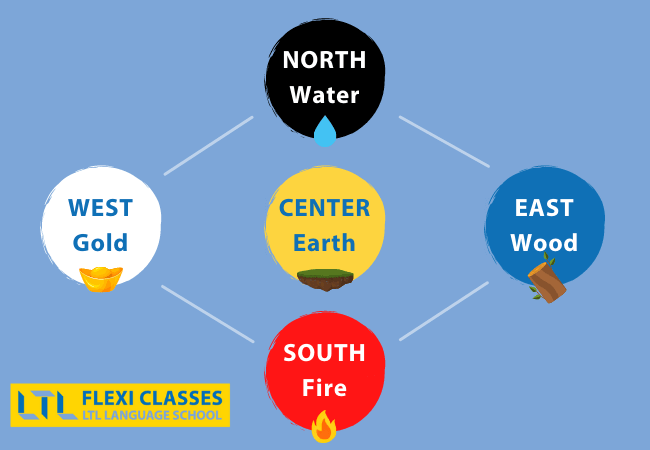
The obangsaek colours each have their own meaning:
- White | The most important colour. Represents truth, humility, purity, and non-possession, as well as the origin of all things.
- Black | Represents wisdom, darkness and death.
- Blue | Represents integrity, brightness and clarity.
- Yellow | Represents wealth, sun brightness and protection.
- Red | Represents creation, passion and love.
These five colours hold such great importance in Korean culture, that it is found in painting, architecture, clothing, food and many more aspects of life.
Including these colours in your food was believed to ensure a healthy life!
Ogansaek 오간색 is another set of five colours made from a mix of the five original ones.
Ogansaek colours are: green, light blue, light red, dark yellow, violet.
Obangsaek and Ogansaek colours make a traditional colour palette used in traditional Korean arts such as architecture, clothing as well as food.
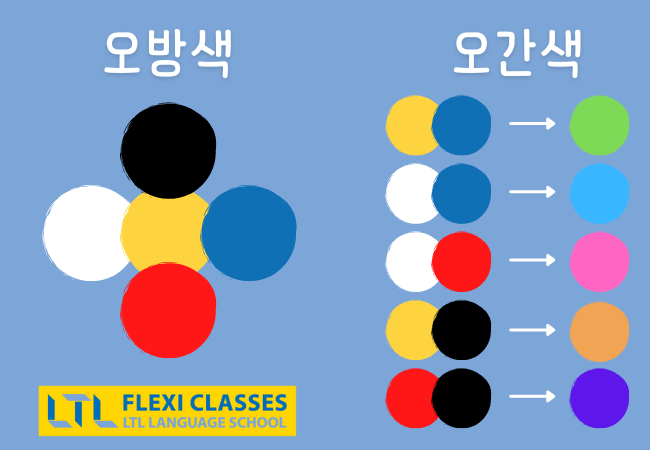
BONUS – TEST YOUR KNOWLEDGE
Now that you’ve come this far, it is time to check if you really paid attention to all colours in Korean!
This short quiz will take 5 minutes to complete, and the results are immediate.
Fancy levelling up your language skills even more? Check out…
- Our guide to Chinese colours
- How to say all the colours in Vietnamese
- Learn 20+ colours in Japanese
Colours in Korean || FAQs
How do you say Colour in Korean?
Colour in Korean is 색깔 [saek-kkal], which is often shortened to 색 [saek].
How do you say Red in Korean?
Red in Korean is 빨간색 [ppalgan-saek].
How do you say Yellow in Korean?
Yellow in Korean is 노란색 [noran-saek].
How do you say Blue in Korean?
Blue in Korean is 파란색 [paran-saek].
What is ‘Obangsaek’ in Korean culture?
Obangsaek 오방색, also called Five Colour Directions, are the five traditional Korean colours which are white, black, blue, yellow and red.
You will notice them in a lot of places in Korea, such as architecture, food and clothing.
What is ‘Ogansaek’ in Korean culture?
Ogansaek (오간색) is another set of five colours made from a mixture of the five original ones.
The 오간색 colours are green, light blue, light red, dark yellow and violet.
Want More From LTL?
FANCY LEARNING KOREAN? Check out our online Korean courses here.
We offer a 7-day free trial to all online students where you can study Korean 24/7.
Want to study Korean in Korea instead? Our Korean courses in Seoul can either be taken in small groups of no more than 5 students or individually for a more tailored experience.
We even offer incredible homestay experiences in Seoul too.
To top it all off, it certainly doesn’t end with Korean. Check out the other languages we teach 👇🏻










